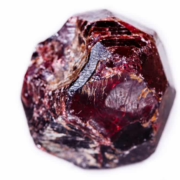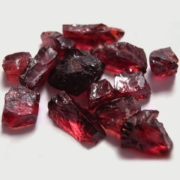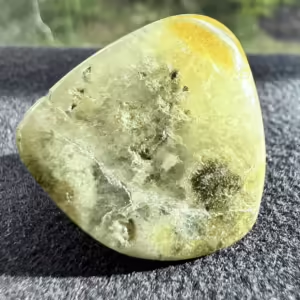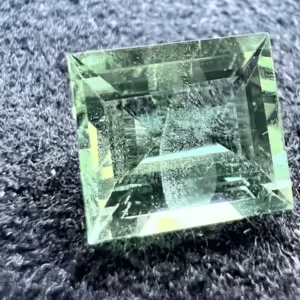Almandine Garnet: Properties, Uses and Virtues
Grenat Almandin: A sought-after garnet!
Almandine, a captivating gem in the garnet family, has been cherished for centuries for its deep red hues and bewitching charm.
Known for its association with passion and vitality, almandine has captured the hearts of gem lovers and jewelry connoisseurs alike.
Let’s embark on a journey together to explore the geological origins, historical significance and mystical properties of this exquisite jewel.

Almandin: table of contents
- Almandine garnet geological formation
- Rough Grenat Almandin – Raw Beauty Revealed
- Sources – The Worldwide Reach of the Almandine Garnet
- Historical Significance of the Almandine Garnet – Through the Ages
- Metaphysical properties of Almandine garnet – Illuminating energies
- Varieties of Almandine Garnet
- Almandine garnet colors
- Durability and wearability of Almandine garnet
- Almandine Garnet Enhancements – Preserving Natural Beauty
- Synthetic Almandine garnet – La Nature en Laboratoire
- Imitations of Almandine Garnet – Discerning the Genuine
- Almandine garnet care – Preserving natural beauty
Almandine garnet geological formation
Almandine, a member of the garnet mineral group, forms under high pressure and is commonly found in metamorphic rocks such as schists and gneisses. Its creation involves the interaction of minerals under intense heat and pressure, leading to the formation of this magnificent jewel deep within the earth’s crust.
Rough Grenat Almandin – Raw Beauty Revealed
The appeal of raw garnet crystals lies in their captivating visual appearance, enhanced by distinctive geometric shapes. Seen through the discerning eyes of gemologists, these uncut gems reveal fascinating structures, with two main shapes, the rhombic dodecahedron and the twenty-four-sided icosahedron, playing an essential role in their identification and appreciation.
Shape of the rhombic dodecahedron :
The visually striking shape of the rhombic dodecahedron is a characteristic feature of raw garnet crystals. Composed of twelve congruent rhombic faces, this symmetrical, well-defined polyhedron fascinates gemologists and gem enthusiasts alike. Recognizing this shape is a crucial identification criterion for garnet, offering valuable information on its unique crystalline arrangement and intrinsic properties.
Icosahedron shape :
Another visually intriguing manifestation found in raw garnet crystals is the icosahedron shape. This polyhedron has twenty-four faces, each composed of equilateral triangles. The icosahedron structure highlights the gem’s symmetry and crystallographic characteristics, enabling gemologists to distinguish and celebrate Garnet among its counterparts.
Sources – The Worldwide Reach of the Almandine Garnet
Almandine is widely distributed around the world and can be found in various regions, including India, Sri Lanka, Brazil, Madagascar and the USA. Each source contributes unique variations in color and clarity, making almandine a diverse and sought-after gem in the jewelry world.
Historical Significance of the Almandine Garnet – Through the Ages
Almandine garnets have a rich history dating back to antiquity, when their captivating appeal was highly prized and traded in the city of “Alabanda”, located in Asia Minor.
The name of this gem originates from this ancient city, where it was highly prized and revered for its remarkable properties.
In the Victorian era, almandine garnets flourished, particularly in the field of mourning jewelry. These gems found their way into the hearts of those mourning lost loved ones, adding a touch of solemn elegance to commemorative pieces, expressing both grief and eternal love.
Over time, almandine garnets came to be known as “carbuncles”, a term derived from the Latin word “carbunculus”, meaning “small glowing firebrand” or “red gem”. In the Middle Ages, this name encompassed a variety of red gems, with almandine garnets occupying a prominent place in this category.
Metaphysical properties of Almandine garnet – Illuminating energies
In the realm of metaphysical beliefs, almandine is considered a stone of strength, courage and vitality. It is believed to promote physical energy and stamina, giving the wearer the power to overcome obstacles and achieve goals. Almandine is also associated with rootedness and protection, shielding the wearer from negative energies and fostering a sense of stability.
Varieties of Almandine Garnet
Depending on the definition, almandine garnet may or may not have varieties.
Color-change garnet can, in rare cases, show a variation in hue from red to red-purple on Idaho almandine and pyrope mixes.
Rhodolite is also recognized as a member of the Almandine family. it is in fact a mix between almandine garnet and pyrope garnet.
Almandine garnet colors
The colors of Almandin garnet cover a spectrum of fiery elegance, from deep reds to purplish reds and reddish browns. Each hue encapsulates the gem’s passionate energy, making almandine a preferred choice for those who desire jewelry that exudes vitality and intensity.
Durability and wearability of Almandine garnet
Almandine has excellent hardness, ranging from 7 to 7.5 on the Mohs scale, making it a durable gemstone suitable for many different types of jewelry. Its robustness ensures that almandine can withstand the rigors of daily wear, retaining its beauty for generations.
Almandine Garnet Enhancements – Preserving Natural Beauty
Almandine is generally untreated and recovered in its natural state. Its captivating red color needs no enhancement to dazzle the observer, and as such, it’s celebrated for its authentic beauty.
Synthetic Almandine garnet – La Nature en Laboratoire
While natural almandine garnets have conquered gem lovers for centuries, the modern era has seen the emergence of synthetic garnets. Synthetic garnets, although they do exist, are not as widespread as other synthetic gems on the market.
These laboratory-created counterparts have been fabricated using a variety of processes, including fusion and hydrothermal processes, to replicate the structure and appearance of natural garnet.
Synthetic garnets have applications beyond the world of jewelry and ornaments. These artificial gems have been developed for specific industrial applications thanks to their remarkable properties.
For example, certain synthetic garnets have become essential components in lasers, optical devices and scientific instruments.
Their composition and consistent optical qualities make them invaluable in a variety of technical fields.
Imitations of Almandine Garnet – Discerning the Genuine
As a prized gemstone, almandine can sometimes be imitated or misrepresented. Buyers should beware of synthetic garnets or other red stones presented as almandine garnets. It is essential to buy from reputable, certified jewelers to ensure the gem’s authenticity.
Almandine garnet care – Preserving natural beauty
Taking care of almandine jewelry ensures its lasting beauty.
To preserve their shine, avoid exposing them to harsh chemicals or sudden temperature changes.
Gently clean the stone with mild soapy water and a soft brush.
Some garnets can be treated with mechanical cleaning, but as a general rule, this is best avoided.
Store almandine jewelry separately from other gemstones to avoid scratches.




Leave a Reply
Want to join the discussion?Feel free to contribute!